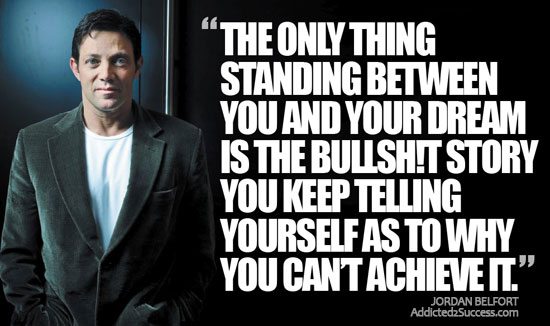Success Advice
14 Lessons We Can All Learn From “The Wolf of Wall Street”
Both the book and the movie “The Wolf of Wall Street” contain many crazy, entertaining, and decadent stories. But beneath all the debauchery there are a number of key lessons for you to learn from the success of Jordan Belfort and Stratton Oakmont.
Read on for some great insight into this motivated business man that will show you how Jordan Belfort was able to build a super pumped organization before it all came tumbling down.
1. Execute on Ideas
Stratton Oakmont’s initial success was based on two premises: That Belfort had come up with a way of teaching young, uneducated people how to sound like professional stock brokers over the phone. That rich people love to gamble – especially when the gamble seems like a legitimate business opportunity. While there had been other people on Wall Street who’d had the same idea, Jordan Belfort was the first person to execute on this idea.
2. Simplify
The reason Belfort was able to transform young, uneducated people into charismatic stock brokers was because he was able to impart his knowledge by giving simple instructions in a way that even the most stupid employees could easily understand.
“And as word of this little secret began to spread throughout Long Island—that there was this wild office, in Lake Success, where all you had to do was show up, follow orders, swear your undying loyalty to the owner, and he would make you rich—young kids started showing up at the boardroom unannounced.” – Jordan Belfort
3. Put Together a Loyal Team
Guys like Kenny Greene and Danny Porush weren’t the smartest guys around. But, they were long-term friends who were fiercely loyal to Jordan Belfort. What does this mean? That it might be a good idea to work with old friends who knew, and liked you, before you got rich and successful.
By doing this you will reduce the risk of: Becoming betrayed or backstabbed by two-faced people and making stupid decisions because you’re surrounded by yes-men who don’t give you accurate feedback.
4. Diversify Competence
Why were Jordan Belfort and Danny Porush a good team? Because they were very different: Belfort had sleeping problems. Porush could fall asleep everywhere – even during bumpy plane rides. Belfort was a highly strategic leader who specialized in delegation. Porush was a good enforcer –brutal enough to eat a gold fish to put employees in their place. Belfort was analytical and had a long-term orientation. Porush was emotional and short-sighted. They were both good at different things – but together they were a great combination.
5. Dress for Success
From day one, employees were instilled with the mantra that they had to act as if – starting by dressing well and looking the part. The purpose of this was to improve their self-esteem and charisma. Jordan Belfort even hired a guy to create tailor-made suits for the up-and-coming employees of Stratton Oakmont.
6. Gather Intelligence on Rivals and Enemies
Belfort gathered intelligence by bugging the SEC people who were investigating Stratton Oakmont and by befriending FBI agent Jim Barsini and getting information about the ongoing investigation on Stratton Oakmont.
7. Guard Your Secrets
Jordan Belfort carefully guarded his secrets by:
• Drafting legal documents to create plausible deniability for shady deals.
• Having the office of Stratton Oakmont and the houses of the top employees swept for bugs regularly.
• Never speaking over the phone about past business deals.
• Using pay phones and other covert forms of communication to ensure that no one listened in on what was being said.
Note: While your business probably differs from Belfort’s by being legal, it’s still a good idea to gather intelligence. For example, you might meet an employee of a rival firm for drinks to learn about the internal gossip going on over there.
8. Study History and Learn From Past Mistakes
Said by Belfort to a Swiss “master forger” while discussing banking laws:
“I’m a student of history, Roland, and I’m a firm believer that he who doesn’t study the mistakes of the past is doomed to repeat them”. – Jordan Belfort
You should follow Belfort’s example by:
• Studying past events in your profession to see what it was that made other people succeed or fail.
• Studying the great men who came before you.
9. Establish a Concrete Reputation
There was never any doubt to the employees, nor the public, that anyone could make a ton of money by working for Stratton Oakmont. To confirm this, the only thing you had to do was take a look at the young, racially diverse, sometimes acne-ridden, well-dressed young men that spread havoc on Long-Island.
“The very idea of Stratton is that it doesn’t matter what family you were born into, or what schools you went to, or whether or not you were voted most likely to succeed in your high-school yearbook. The idea of Stratton is that when you come here and step into the boardroom for the first time, you start your life anew. The very moment you walk through the door and pledge your loyalty to the firm, you become part of the family, and you become a Strattonite.” – Jordan Belfort
10. Create a Set of Core Values that is Easy to Grasp
The core value of Stratton Oakmont was to seize the day. What this really meant to the employees was to:
• Make as much money as possible.
• Compete with colleges who could spend more money and live a crazier and more luxurious lifestyle.
–And what are some common core values of contemporary companies?
• Sustainability.
• Environmental friendliness.
• Integrity.
Which core values do you think are easier to communicate to the employees and make them live by?
11. Lead by Example and Set the Standard
No one over at Stratton Oakmont spent more money on buying luxury items, drugs, prostitutes, or partying than Jordan Belfort. He represented the epitome of the lifestyle that the employees sought to achieve.
“It’s important to keep these guys chasing the dream. And it’s even more important to keep them broke.” I gestured over to the plate glass. “Look at them; as much money as they make, every last one of them is broke! They spend every dime they have, trying to keep up with my lifestyle. But they can’t, because they don’t make enough”. – Jordan Belfort
12. Create Expectations
At Stratton Oakmont employees were expected to work their asses off and make a lot of money. Anything else was frowned upon.
“A rookie stockbroker was expected to make $250,000 his first year. Anything less and he was suspect. By year two you were making $500,000 or you were considered weak and worthless. And by year three you’d better be making a million or more or you were a complete f#%$ing laughingstock.” – Jordan Belfort
13. Provide Incentives for Hard Work
Not only were the employees of Stratton Oakmont paid far above the going rate for stock brokers – but a select few of the hardest working employees were also eligible to branch out on their own and start brokerage firms under Belfort’s guidance.
“It was what every Strattonite dreamed of and something I touched upon in all my meetings—that if you continued to work hard and stay loyal, one day I’d tap you on the shoulder and set you up in business. And then you would get truly rich.” – Jordan Belfort
14. Keep People Dependent on You
To ensure that employees were not only motivated to work, but literally had to stay at the firm and continue making lots money, Belfort encouraged employees to live beyond their means.
“I want you to deal with all your problems by becoming rich! I want you to attack your problems head-on! I want you to go out and start spending money right now. I want you to leverage yourself. I want you to back yourself into a corner. Give yourself no choice but to succeed. Let the consequences of failure become so dire and so unthinkable that you’ll have no choice but to do whatever it takes to succeed.” – Jordan Belfort

————
Question:
Are there more lessons to be learned from the Wolf of Wall Street? If you have any of your own, please leave them in the comments section below.
Did You Know
How Skilled Migrants Are Building Successful Careers After Moving Countries
Behind every successful skilled migrant career is a mix of resilience, strategy, and navigating systems built for locals.

Moving to a new country for work is exciting, but it can also be unnerving. Skilled migrants leave behind familiar systems, networks, and support to pursue better job opportunities and a better future for their families. (more…)
Life
10 Research-Backed Steps to Create Real Change This New Year
This New Year could finally be the one where you break old patterns and create real, lasting change.

Every New Year, we make plans and set goals, but often repeat old patterns. (more…)
Change Your Mindset
The Silent Skill That Makes People Respect You Instantly
What truly earns respect and why most people go about it the wrong way

Everybody craves respect but not everyone earns it. Some people believe that a title, years of experience, or a position of authority automatically entitles them to respect. (more…)
Entrepreneurs
The Essential Skills Every Entrepreneur Needs In 2026
Success in the digital age isn’t about luck. It’s about mastering the skills that separate dreamers from doers.

When I was 22 years old, I started my first side hustle as a ghostwriter. (more…)
-

 Shift Your Mindset4 weeks ago
Shift Your Mindset4 weeks ago11 E’s That Define Every Great Leader And Why Most People Miss Them
-

 Did You Know4 weeks ago
Did You Know4 weeks agoThe Success Patterns You Inherited (And Didn’t Notice)
-

 Entrepreneurs3 weeks ago
Entrepreneurs3 weeks agoThe Essential Skills Every Entrepreneur Needs In 2026
-

 Business4 weeks ago
Business4 weeks agoThe Hidden Money Pit in Your Operations (and How to Use It)
-

 Change Your Mindset2 weeks ago
Change Your Mindset2 weeks agoHow to Turn Your Mind Into Your Greatest Asset (Instead of Your Enemy)
-

 Change Your Mindset2 weeks ago
Change Your Mindset2 weeks agoThe Silent Skill That Makes People Respect You Instantly
-

 Life2 weeks ago
Life2 weeks ago10 Research-Backed Steps to Create Real Change This New Year
-

 Tech1 week ago
Tech1 week agoWhat’s in a Name? How to Get Your Domain Right























75 Comments